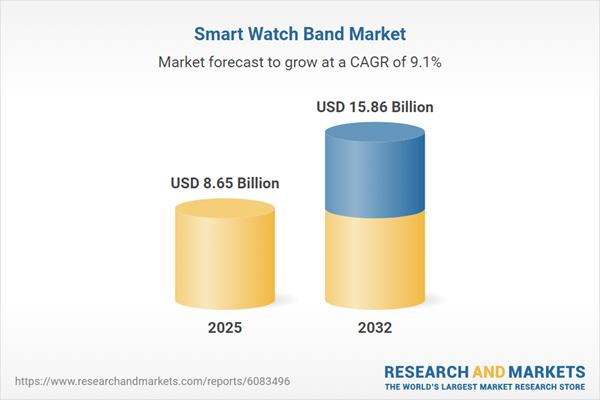Speak directly to the analyst to clarify any post sales queries you may have.
The smart watch band market is evolving rapidly, shaped by rising standards for materials, flexibility in design, and enhanced digital capabilities. Senior decision-makers must track advances and anticipate changing customer needs to capture significant opportunities as wearable devices proliferate.
Market Snapshot: Smart Watch Band Market Size and Growth Outlook
The smart watch band market is undergoing strong expansion, growing from USD 7.92 billion in 2024 to USD 8.65 billion in 2025, and is forecast to reach USD 15.86 billion by 2032 at a compound annual growth rate (CAGR) of 9.05%. Sustained momentum is driven by steady progress in ergonomic material science, personalized features, and increased adoption across both consumer and enterprise contexts. With further advances in connected solutions and greater segmentation, diverse industries and demographics continue to drive broader uptake of smart watch bands in global regions.
Scope & Segmentation
This report delivers a detailed assessment of the smart watch band market’s structure, highlighting the factors shaping competition, industry trends, and key buyer and supplier influences. The analysis covers the following critical segments and dynamics:
- Material Types: Fabric, leather, metal, and silicone selections provide wide-ranging choices for comfort, durability, and commitment to environmentally responsible products.
- Band Types: Both interchangeable and non-interchangeable models offer flexibility for personalization and adaptation to diverse user needs and style preferences.
- Age Groups: Offerings for adults, teens, kids, and seniors address the full spectrum of lifestyle, wellness, and fashion-driven considerations within the market.
- Gender Preferences: Products tailored for male and female users further refine the balance between aesthetics and functional requirements.
- Distribution Channels: Offline platforms like brand and specialty stores emphasize direct engagement, while online channels, including mobile apps and web platforms, leverage customization and seamless purchasing capabilities.
- Regional Coverage: Dedicated analyses for the Americas, Europe, Middle East & Africa, and Asia-Pacific capture local demographic trends, technology adoption rates, and retail developments affecting smart watch band sales.
- Technology Integration: Adoption of biometric sensors, antimicrobial surface treatments, near-field communication, quick-release systems, adaptive fit designs, modular construction, and compatibility across device platforms contributes to enhanced product effectiveness and user engagement.
- Key Companies Analyzed: In-depth profiles of major industry participants, including Apple Inc., Samsung Electronics Co., Ltd., Huawei Technologies Co., Ltd., Xiaomi Corporation, Guangdong OPPO Mobile Telecommunications Corp., Ltd., Zitel, Garmin Ltd., Google LLC, Mobvoi Information Technology Company Limited, and Fossil Group, Inc., provide benchmarks for innovation and strategy.
Key Takeaways for Senior Leaders
- The smart watch band market is positioned at the intersection of wearable technology adoption and heightened consumer experience, where personalization and digital integration set the pace for product differentiation.
- Emerging material technologies, such as advanced polymers and recycled silicone, support the convergence of long-term sustainability with performance and comfort expectations for end users.
- Modular product designs and collaborative development initiatives offer manufacturers and brands opportunities to build recurring customer engagement and extend the relevance of existing portfolios.
- Retail strategies are becoming more targeted, as immersive offline experiences highlight tactile evaluation and premium positioning, while online platforms expand access to visualization tools and style customization options for discerning customers.
- Increasingly granular demographic targeting leverages usability and comfort to drive uptake among adults and seniors; for younger segments, bold design and integrated functionality are leading drivers of adoption.
Tariff Impact and Supply Chain Response
Recent tariff policy changes in the United States have prompted manufacturers of smart watch bands to reevaluate their sourcing and material strategies. In response, industry players are developing new supplier partnerships, streamlining logistics, and turning to smart manufacturing practices. These proactive measures strengthen supply chain resilience and agility, helping companies to adapt quickly and maintain compliance within evolving regulatory environments.
Methodology & Data Sources
Research draws on primary interviews with material scientists, engineers, and supply chain experts, complemented by secondary data from published industry analyses, patent records, regulatory documents, and manufacturer disclosures. The approach comprises structured value chain mapping and focused regional segmentation to develop actionable strategies and evidence-based insights.
Why This Report Matters
- Delivers actionable intelligence for making strategic decisions in materials selection, product development, and channel alignment as market conditions evolve.
- Equips organizations to forecast and address regional and demographic trends shaping buyer preferences and technology innovation.
- Enables robust benchmarking and in-depth competitive review, offering insight critical to sustaining market position.
Conclusion
Breakthroughs in materials, digital features, and region-specific strategies are aligning to open substantial opportunities within the smart watch band market. Responsive leadership and timely adaptation will be essential for capturing long-term value amid ongoing advances in wearable technology.
Table of Contents
3. Executive Summary
4. Market Overview
7. Cumulative Impact of Artificial Intelligence 2025
Companies Mentioned
The companies profiled in this Smart Watch Band market report include:- Apple Inc.
- Samsung Electronics Co., Ltd.
- Huawei Technologies Co., Ltd.
- Xiaomi Corporation
- Guangdong OPPO Mobile Telecommunications Corp., Ltd.
- Zitel
- Garmin Ltd.
- Google LLC
- Mobvoi Information Technology Company Limited
- Fossil Group, Inc.
Table Information
| Report Attribute | Details |
|---|---|
| No. of Pages | 181 |
| Published | November 2025 |
| Forecast Period | 2025 - 2032 |
| Estimated Market Value ( USD | $ 8.65 Billion |
| Forecasted Market Value ( USD | $ 15.86 Billion |
| Compound Annual Growth Rate | 9.0% |
| Regions Covered | Global |
| No. of Companies Mentioned | 11 |









